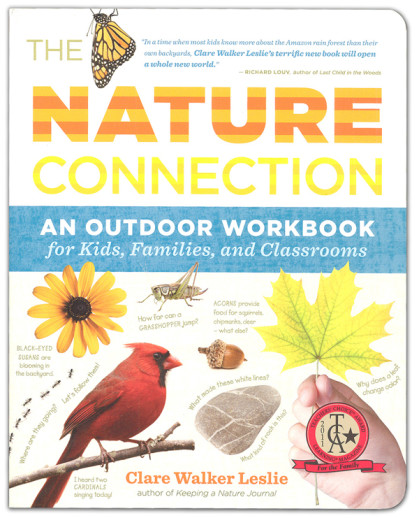We use cookies to make your experience better. To comply with the new e-Privacy directive, we need to ask for your consent to set the cookies. Learn more.
Nature Connection
More structured than a nature journal, this "outdoor workbook" is a great tool for families and students who prefer some guided instruction and inspiration as they observe, record, and learn from nature throughout the year. It features a varied, interactive format that kids won't soon get bored with, great forms for observation you can print from the publisher's website, and lots of terrific activity suggestions. The book is divided into three parts: "How to Be a Naturalist," "Learning the Sky," and "Exploring Nature." The first part introduces students to the skills and tools of the naturalist, provides suggestions and forms for setting up a nature journal, offers ideas for observation and appreciation (listing species that live in your neighborhood, making a "nature arrangement" or using observations to write a nature poem), and even includes quick drawing lessons that all culminate in an "field expedition." Because weather plays such a large role in nature, it gets its own chapter, and students are encouraged to draw the sky over different days and times, "read" clouds, draw a weather map, learn why we have seasons, play with shadows, keep a moon journal, discover nocturnal animals, learn three constellations and write a sky poem. The majority of "Exploring Nature" is organized by month (January-December) and provides specific activities and mini-lessons on seasonal nature topics. In March students will learn about the spring equinox, check for life in small pools of water and streams, turn over logs and rocks, draw birds, observe and draw budding twigs, and much more. In August, the focus is on water (the book assumes a family vacation here!) and students learn about the water cycle, find out more about a local stream or river, experiment with water, learn about water creatures, find sources of water in nature, keep a nature journal on vacation, and sleep under the stars. Several forms are provided for all months, including "Nature Notes" and "Nature Quest" forms, and a blank page for a "Picture of the Month." You can print more of these online for ongoing observation projects. Quite a few helpful resources for parents can be found in the appendix, such as safety information, suggestions on how to use nature journals in teaching and how to use the book to meet state curriculum standards, a bibliography (including suggested field guides and books for kids), recommended websites and a list of nature organizations. If you're new to nature studies and looking for some time-saving forms and activity suggestions, this is a resource to consider and its reasonable enough you may want to get each child their own copy. Jess
| Product Format: | Softcover Book |
|---|---|
| Brand: | Storey Books |
| Author: | Clare Walker Leslie |
| Grades: | 2-8 |
| ISBN: | 9781603425315 |
| Length in Inches: | 9.25 |
| Width in Inches: | 7.5 |
| Height in Inches: | 0.875 |
| Weight in Pounds: | 1.45 |

